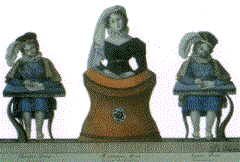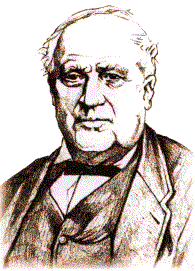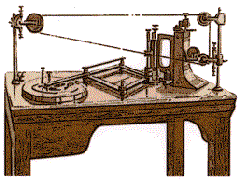|









|
|
| It was upon a time ... |
| |
|
| Jean-Frédéric Leschot (1746-1824)
exceptional watchmaker, genius mechanics. Adoptive son of Pierre Jaquet-Droz, who participated in the construction and making of
ingenious Automatons which performed the most incredible things such
as writing, drawing a picture, playing the piano, in other words
precursors of our modern day computers. He also produced complicated
musical clocks, as well as making artificial limbs (prosthesis of
artificial limbs).
He also invented a wheel-cutting machine for watch
movements and built a device to demonstrate the theory of watch
movement gearing. In 1782, he became partners with H.-L Jaquet-Droz
and in 1784 they established themselves and their company in Geneva.
In 1787 they received the title of 'Honorable Citizen of Geneva'. |

|
| |
|
 |
They
produced clocks, luxurious watches, wristwatches, self-winding
'perpetual' watches, marvelous
jewels, singing birds and artificial limbs.
The
watch-making industry owes great recognition to Jean-Frederic
Leschot in terms of technical, industrial, artistical, and
commercial
development.
Source:
Muske d’Art et d’Histoire, Neucâtel (Suisse) |
| |
|
| Georges-Auguste Leschot (1800-1884)
son of Jean-François Leschot, pioneer in the watch industry by
introducing the inter-changeability of watch components being part
of watch movements. Having the distinctive qualities of a genius in
the watch-making field, he applied those qualities to build watches
of exceptional quality at the same time creating the machines to
produce them ! |

|
| |
|
 |
His
invention of draw in lever escape wheel contributed to the universal
adoption in the watch industry worldwide. In 1845, with Vacheron
& Constantin of Geneva, he received from Geneva’s Society of
the Arts the official prize 'Auguste de la Rives'.
He
also invented a 'diamond drill' for rock piercing and deep well
drilling. This invention was patented in 1862 and facilitated the
piercing of a majority of tunnels in the world, such as the
'GOTHARD' in the Swiss Alps, as well as oil deep well drilling.
This
method is still used today worldwide. |
| |
|
| Source
: Bulletin annuel de la Sociète Suisse de Chronométrie 1940. |
|
|